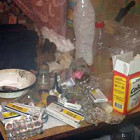
Russia Plagued by Flesh-Rotting Heroin Alternative
|
In Russia, a nation with more heroin users than any other in the world, addicts are finding a new, even more devastating way to get high. The drug is desomorphine, a synthetic opiate, but users know it as krokodil, or “crocodile,” because the skin at the injection site turns scaly, grey and reptilian as the surrounding tissue dies. Krokodil is derived from codeine (available over-the-counter in Russia) and freely available household products and it costs a fraction of what true heroin would cost. Although the price in rubles may be low, the physical cost is tremendous. Desomorphine is essentially poison and addicts soon find their skin dying and falling away leaving exposed bone. Sores grow over their bodies or they develop abscesses where the needle misses a vein. Already, 30,000 Russians die each year from heroin overdoses, according to The Independent, but now as many as 100,000 Russians are addicted to krokodil and other homemade drugs. Desomorphine is highly addictive with terrible withdrawal symptoms lasting up to a month. In the poorest parts of Russia where heroin is scarce, krokodil is gaining a strong foothold, due in large part tothe availability of codeine tablets over the counter in the Russian pharmacies. Addicts create the desomorphine by “cooking,” a process that can take up to half-an-hour. Unlike heroin, however, the high is of a shorter duration. Addicts soon find themselves entrenched in a nearly unstoppable cycle of “cooking” and getting high.
